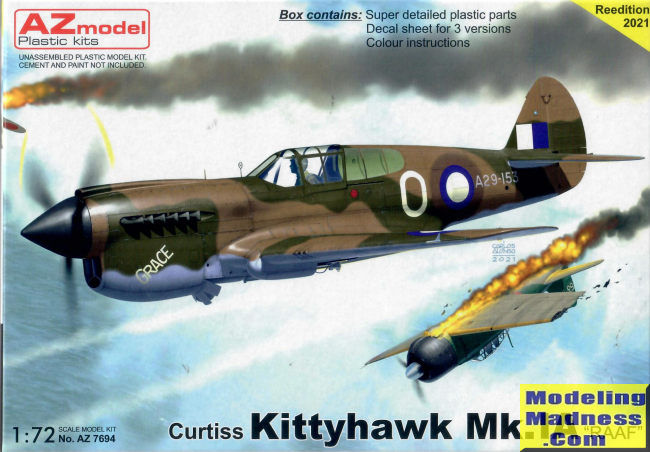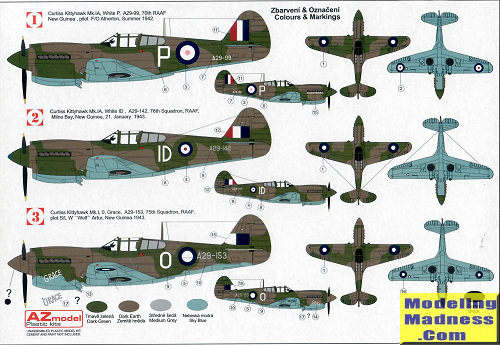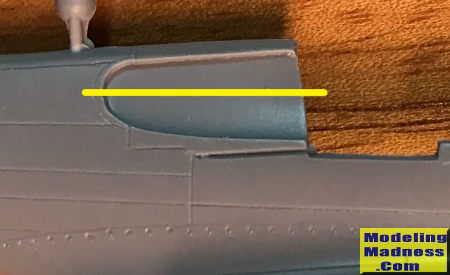
| KIT #: | 7694 |
| PRICE: | $20.00 or so |
| DECALS: | Three options |
| REVIEWER: | Thomas Hall |
| NOTES: | 2012 tooling |

| HISTORY |
The Curtiss Kittyhawk Ia was an export machine and was sometimes known as the P-40E-1 or Hawk 87A-2. Exactly 1,500 were built, the first batch being 420 units (US serials 41-24776 through 41-25195) and the second being 1,080 (US serials 41-35874 through 41-36953). Manufacturing began around the time of the Pearl Harbor attack and ended in June 1942.
Royal Australian Air Force (RAAF) P-40E-1s are easily confused with their P-40Es. The two are best distinguished by the serial numbers the RAAF painted on the rear fuselage of each plane, once you know which numbers were assigned to E-1s! In addition, RAAF E-1s had an external rear-view mirror on top of the windscreen. Early E-1s had ID lights on both sides of the fuselage, in the British manner.
The RAAF received approximately 78 of the P-40E-1. Most or all went from Buffalo, New York through the Port of San Francisco, then by ship to Australia. The RAAF assigned their Kittyhawk Ia’s to Nos. 75, 76, and 77 Squadrons and turned many of the long-term survivors into advanced trainers at No. 2 Operational Training Unit. RAAF Kittyhawk Ia’s were active in Australia and Papua from March 1942, including fighting around Port Moresby and Milne Bay. (Most of these details are not supplied in the history in the kit instructions.)
| THE KIT |
This is a 2021 reissue of Legato AZL 7224, but with decals for the RAAF E-1. The sprues are also apparently identical to AZ kits 7400, 7693, 7695, and 7696. This kit is not to be confused with Special Hobby’s or Sword’s kits of the P-40E in 1/72 scale; those sprues are different.
Minuses
The box has some questionable things. Markings Option 1 is aircraft A29-99. AZ place it in “70th RAAF”, but there was no 70 Squadron. Website ADF Serials connects that airplane to No. 75 Squadron.
 Then there is
the underside color. The E-1 went into production before the RAAF selected its
Sky Blue for the underside. A29-153 (markings option 3 in the kit) was a very
early E-1, so AZ’s depiction is not the factory-applied underside color. The
Australian grapevine tells us that there is a relic from the underside of an
RAAF P-40E-1 that is “grey”. This was once thought to refer to the American idea
of RAF Sky Grey. If so, somewhat like FS 36463. Another theory has Curtiss
applying Dupont’s concept of RAF Sky Type S, as specified on their drawings of
the camouflage pattern. There is also a theory that the RAAF quickly repainted
the undersides of its P-40s in RAAF Sky Blue after deciding on that color
sometime in 1942. Nearly 30 years ago, Ian Baker depicted Sky Blue as a bit
darker than FS 35550. AZ’s rendering of Sky Blue on the back of the box is much
too dark. It would have been better if AZ had suggested a few model paints, but
they may have found the issue too daunting. The box top fails to show the
rear-view mirror.
Then there is
the underside color. The E-1 went into production before the RAAF selected its
Sky Blue for the underside. A29-153 (markings option 3 in the kit) was a very
early E-1, so AZ’s depiction is not the factory-applied underside color. The
Australian grapevine tells us that there is a relic from the underside of an
RAAF P-40E-1 that is “grey”. This was once thought to refer to the American idea
of RAF Sky Grey. If so, somewhat like FS 36463. Another theory has Curtiss
applying Dupont’s concept of RAF Sky Type S, as specified on their drawings of
the camouflage pattern. There is also a theory that the RAAF quickly repainted
the undersides of its P-40s in RAAF Sky Blue after deciding on that color
sometime in 1942. Nearly 30 years ago, Ian Baker depicted Sky Blue as a bit
darker than FS 35550. AZ’s rendering of Sky Blue on the back of the box is much
too dark. It would have been better if AZ had suggested a few model paints, but
they may have found the issue too daunting. The box top fails to show the
rear-view mirror.
 Turning to the
plastic parts, the windscreen lacks the rear-view mirror.
In addition, as Airfix and Hasegawa did decades ago, AZ
has given the rear quarter of the canopy a straight edge across the top.
Actually, this removable section of Plexiglas had the general shape of a tall
parabola laid on its side. Its outline had bilateral symmetry or very close to
it, but the kit parts do not. The tunnel at the ventral centerline is possibly a
bit too wide. The openings for the exhaust stacks lack the dividers between
stacks.
Turning to the
plastic parts, the windscreen lacks the rear-view mirror.
In addition, as Airfix and Hasegawa did decades ago, AZ
has given the rear quarter of the canopy a straight edge across the top.
Actually, this removable section of Plexiglas had the general shape of a tall
parabola laid on its side. Its outline had bilateral symmetry or very close to
it, but the kit parts do not. The tunnel at the ventral centerline is possibly a
bit too wide. The openings for the exhaust stacks lack the dividers between
stacks.
The E-1 usually had the Sutton harness. That is not what is molded onto the seat, though. (A Sutton harness would have a Y-strap down the back of the seat back, with its upper straps attached to other straps spaced shoulder-width at the top of the seat back.) No pilot, resin or brass parts are supplied.
Plusses
Mostly accurate lines. For example, the fairings for the main landing gear legs are better than those on the Hasegawa P-40s in 1/72 scale. Good scribing; detailed floor and cockpit sides; separate rudder; wheels of two kinds; drop tank included; crystal clear canopy; high-quality decals.
| CONCLUSIONS |
While I can’t call this the perfect P-40E or E-1 kit, I can at least say, “No regrets, mate.” I give it a grade of “B”. If the battle for Papua and New Guinea is your thing, the interesting color scheme will add variety to your collection.
| REFERENCES |
ADF Serials https://www.adf-serials.com.au/2a29b.htm
Australian War Memorial photos 026645, 044669, PO 3869.003
https://www.awm.gov.au/collection/REL%3A20242
Aviation History Colouring Book, Vol. 13, Ian Baker (1995)
https://www.cybermodeler.com/history/meteor/cresswell.shtml, citing Dana Bell
https://rnzaf.proboards.com/thread/29401/paint-schemes-applied-export-kittyhawks,
showing Curtiss
drawings for RAF paint schemes.
October 2023 Copyright
ModelingMadness.com. All rights reserved. No reproduction in part or in whole
without express permission. If you would like your product reviewed fairly and fairly quickly, please
contact
the editor or see other details in the
Note to
Contributors.